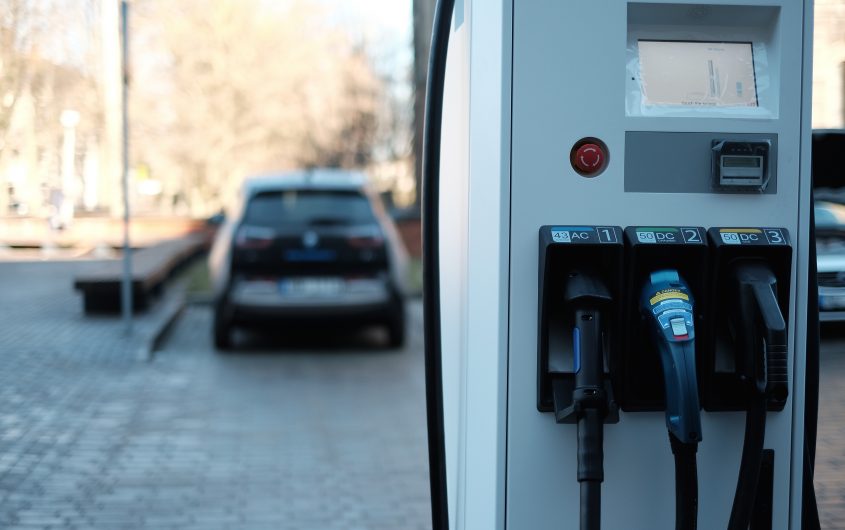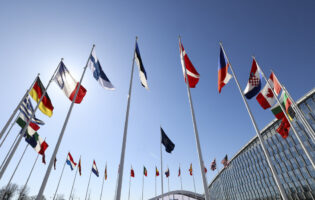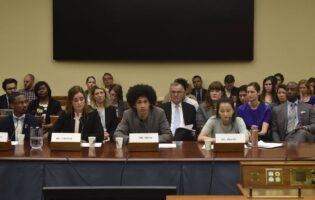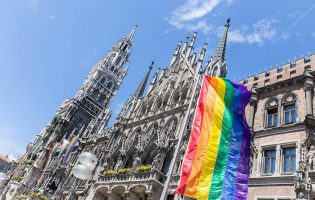
Kārlis Dambrāns via Flickr
U.S. and German Energy Policy at a Crossroads? The Transatlantic Partners and the Future of Energy Cooperation

Sonja Thielges
Institute for Advanced Sustainability Studies
Sonja Thielges is a Geoeconomics Non-Resident Fellow and was a DAAD/AICGS Research Fellow from mid-March to mid-May 2019 and explored foreign policy interests in Germany and the U.S. related to the countries’ energy transitions. In Germany, she is a senior research associate in the project “Pathways to Sustainable Energy” at the Institute for Advanced Sustainability Studies (IASS) in Potsdam. Sonja’s research interests include the international dimension of the energy transition, foreign energy policy, the G20 energy agenda, as well as U.S. energy and climate policy. Her research has been published in studies, policy papers, online blogs, and academic publications.
Prior to IASS, Sonja worked in the Americas Division at the German Institute for International and Security Affairs (SWP) in Berlin, focusing on U.S. climate and energy policy. She was a visiting researcher at the University of Michigan’s Center for Local, State, and Urban Policy in Ann Arbor in 2014 and previously also worked on projects at the Environmental Policy Research Centre (FFU), the Institut für Europäische Politik (IEP) Berlin, and the Centre International de Formation Européenne (CIFE). In 2017/2018, Sonja was a participant in the AICGS project “A German-American Dialogue of the Next Generation: Global Responsibility, Joint Engagement,” sponsored by the Transatlantik-Programm der Bundesrepublik Deutschland aus Mitteln des European Recovery Program (ERP) des Bundesministeriums für Wirtschaft und Energie (BMWi). She completed an M.A. in North American Studies, Political Science, and Modern History at Freie Universität Berlin and Indiana University Bloomington and holds a PhD in political science from Freie Universität Berlin. Her PhD thesis studied climate policy discourses in the U.S. Rust Belt states.
I therefore propose that we have a discussion in the climate cabinet about how we could reach the goal of being CO2 neutral by 2050 and the discussion should not be about whether we can reach that goal but about how we will reach it.
– Angela Merkel, Speech at the Petersberg Climate Dialogue, Berlin, May 2019
The Paris Agreement handicaps the United States economy […]. [O]ur withdrawal from the agreement represents a reassertion of America’s sovereignty […]. Staying in the agreement could also pose serious obstacles for the United States as we begin the process of unlocking the restrictions on America’s abundant energy reserves, which we have started very strongly.
– Donald Trump, Statement on the Paris Climate Accord, Washington, DC, June 2017
The U.S. and Germany are moving in fundamentally different directions with their energy policies. Germany has embarked on its “Energiewende,” an energy strategy based on renewable energy and energy efficiency as well as the phase-out of fossil fuels and nuclear energy. It is an important building block in the country’s climate protection endeavors. The U.S. under the Trump administration has abandoned its national and international climate commitments. It is pursuing an “Energy Dominance” strategy that seeks to expand the production of U.S. coal, natural gas, and oil. This strategy marks a significant departure from the Obama administration, which pursued a climate action plan focused on fostering clean energy in the U.S. and abroad.
This policy shift in the U.S. is not universally perceived as straightforward policy reversal. Conversations with energy experts in Washington, DC, in the spring of 2019 yield two different interpretations. Some believe that “not much has changed” in terms of climate and sustainable energy since President Trump took office. To others, “everything has changed” and the situation for sustainable energy is “very bad,” even “an embarrassment.” How can there be such different perceptions of current energy policy? And what does this mean for the potential of transatlantic clean energy cooperation?
This essay sheds some light on these questions. It shows that there is truth to both sides: The Trump administration’s energy policy, in contrast to its predecessor’s, no longer focuses on fostering sustainable energy. This creates some tensions with the climate and energy policy goals of the German government. However, in its international efforts, the U.S. continues to support renewable energy and energy efficiency. Shared energy policy interests between the U.S. and Germany thus persist and the essay concludes with some ideas on how this could translate into transatlantic energy cooperation.
The U.S. Energy Dominance Agenda
An early focus of the Trump administration’s energy strategy was to eliminate climate protection programs and regulations set up by the Obama administration. The current budget proposal for fiscal year 2020, for instance, would eliminate most funding for climate programs at the Environmental Protection Agency (EPA). Trump’s central energy policy goal is to eliminate environmental regulation which, in his view, limits the country’s production of coal, gas, and oil. A “powerful America,” the administration explains in its National Security Strategy (NSS), is based on unleashing the nation’s “abundant energy resources.”
As with other policy areas, the Trump administration has demonstrated a general unwillingness to operate its energy policy within a multilateral framework. Instead, the Trump administration’s energy policy is driven by the familiar “America First” paradigm. The administration has withdrawn its engagement from several international formats to foster clean energy, such as the Extractives Industries Transparency Initiative (EITI), and is “reviewing” its commitments under most of the Clean Energy Ministerial’s (CEM) working groups, such as the Multilateral Solar and Wind Working Group. The U.S. no longer contributes to the UN Green Climate Fund and has distanced itself from its fellow G20 and G7 members on questions of climate protection and clean energy.
The German Climate and Sustainable Energy Agenda
The goal of nearly decarbonized energy systems, to be achieved especially by focusing on renewable energies, energy conservation and the highest possible energy efficiency, latest by 2050, is an important Leitbild of national climate and energy policy as well as energy foreign policy and development policy.
– German Federal Government, 2019
The Trump administration’s Energy Dominance strategy creates some friction with the goals and approach of the German Energiewende, which includes ambitious renewable energy and energy conservation goals. Germany’s Energiewende does not stop at its borders. It has an international dimension. The German government fosters its goal of a global energy transition internationally through bilateral and multilateral engagement and initiatives. It hosts some twenty energy partnerships and dialogues in order to promote sustainable energy with its partner countries. The government funds climate protection projects through efforts such as the International Climate Initiative (IKI). It supports capacity building for sustainable energy in developing countries through the energy portfolio of its development ministry. Moreover, the German government promotes sustainable energy in fora such as the G20 and it was instrumental in setting up the International Renewable Energy Agency (IRENA).
Despite its ambitions, the German economy remains highly dependent on fossil fuels, which still supply some 80 percent of its energy today. As Germany has few fossil fuel resources of its own, it is a net importer of oil, gas, and coal. Russia is already the main supplier for all three, which has led the Trump administration to criticize German efforts to tighten its energy ties to Russia even further through the construction of the “Nord Stream 2” gas pipeline.
The Geopolitics of Foreign Energy Policy
Transatlantic disagreements over energy issues are not just limited to Germany’s dependence on Russian energy imports, as climate protection and global sustainable energy transformation are no longer shared goals. As a lowest common denominator, both countries share an interest in energy security. But while for the U.S. this means increasing and diversifying energy supply at home and abroad, for Germany it means reducing import dependence and increasing supply security.
The Trump administration’s foreign policy strategy is meant to ensure U.S. leadership in international energy markets and influence in the international system. It perceives its international energy policy, whether it unfolds through energy exports or development policy, as a means to offer partners alternatives to Chinese and Russian involvement in energy markets.
Today, the United States must compete for positive relationships around the world. China and Russia target their investments in the developing world to expand influence and gain competitive advantages against the United States.
– U.S. National Security Strategy, 2017
This is quite in contrast to the German foreign policy approach in which Russia and China do not figure nearly as prominently. At the May 2019 Petersberg Climate Dialogue, Chancellor Merkel rather praised China on the expansion of renewable energy and the way it “face[s] up to the challenges posed by climate change.”
Continued U.S. Efforts in Clean Energy Promotion?
What this means in practice is that the U.S. doesn’t limit itself to promoting fossil fuels abroad. For geopolitical reasons, it also continues to support clean energy, for instance through its efforts to promote energy access in Africa and the Asia Pacific, because in many countries they are the most economical alternative in setting up electricity supply and the U.S. has an interest in maintaining close relations with these countries.
The Power Africa program, for instance, is a public-private partnership launched in 2013 during the Obama administration. It seeks to increase investment to improve energy security and economic growth and fight poverty in African countries. Its target is to create new generation capacity (mostly gas, solar, wind, and hydro) and improve transmission infrastructure. In 2018, the Trump administration added a Gas Roadmap to the program, which aims at adding 16,000 MW in gas-fired power generation in Sub-Saharan Africa by 2030. USAID estimates that this could result in at least $5 billion in U.S. LNG exports by 2030.
In 2018, the Trump administration issued its Indo Pacific Strategy, a reaction to the ever-increasing activities of China in the region. One of the instruments to implement this strategy is Asia “EDGE” (Enhancing Development and Growth through Energy). Through this initiative, the U.S. government will invest some $50 million a year to support regional energy trade and integration, the deployment of advanced energy systems, and utility modernization. Various USAID programs support Asia EDGE. Among them are “Clean Power Asia,” an initiative to foster renewable energy in the ASEAN countries, and Greening the Grid, a USAID technical assistance initiative in cooperation with the National Renewable Energy Laboratory (NREL). Asia EDGE also includes programs to promote the construction of LNG infrastructure and projects to supply LNG in the region.
The U.S. also offers assistance on clean energy policy through its Clean Energy Solutions Center in cooperation with the governments of Australia, Mexico, and Sweden under the framework of the Clean Energy Ministerial. The programs and policies aim to support the deployment of low-carbon technology.
In addition to its USAID programs, the U.S. development finance institution OPIC (Overseas Private Investment Corporation) spends almost half of its $29 billion budget in electricity projects. Most of this is spent in renewable energy with a current regional focus on Africa, Latin America, and the Indo-Pacific. In October 2019, the U.S. government will launch OPIC’s successor institution, the U.S. International Development Finance Corporation (DFC). At $60 billion, its investment cap will be twice as high as OPIC’s. One of the focal points of DFC’s work will be on energy, as recent expert interviews in Washington, DC, suggested. In addition to new tools such as loans and loan guarantees, DFC will be able to make equity investments. It will further have the ability not only to support U.S. businesses, but also foreign companies. With its new development finance institution, the U.S. seeks to provide “financially-sound alternatives to state-led initiatives from countries like China.”
Ideas on the Potential of Transatlantic Clean Energy Cooperation
Despite the Trump administration’s focus on promoting fossil fuels, a closer look at foreign policy instruments thus reveals that the U.S. and Germany still have a common interest in promoting sustainable energy abroad—albeit for different reasons. Having a common interest among the transatlantic partners does not, of course, translate automatically into cooperation and common policy approaches. In many cases, the complexity of coordinating, especially when it comes to development policy, may simply be too high. Nevertheless, my conversations with energy experts in Washington, DC, and Berlin suggested that there are areas that bear the potential for cooperation toward global emission reductions and the advancement of clean energy. Some of them are yet untapped, some of them could be expanded.
Enhancing such cooperation is not trivial: Through their foreign energy policy, both countries are shaping energy systems on a global scale, building up energy infrastructure which may determine energy supply in their partner countries for decades to come. Their international energy policy efforts may thus also determine their relationships with their partners vis-à-vis large energy players such as China, Russia, and the OPEC countries for the foreseeable future. The countries’ international efforts to promote sustainable energy will, at the same time, play an important role in determining whether internationally-agreed targets such as the climate goals of the Paris Agreement can be achieved.
Enhancing Cooperation at Different Governance Levels
The German government already supports transatlantic cooperation for climate protection and sustainable energy through its Transatlantic Climate Bridge. This initiative, launched in 2008 by the environment ministry, provides a platform for dialogue among subnational actors on issues of sustainable energy and climate protection. The German federal government itself engages in a so-called Energy Dialogue with U.S. states such as California and New York, fostering exchange of best practices on renewable energy deployment and energy efficiency measures. The focus here is on like-minded subnational actors with an interest in climate protection. Further cooperation takes place through coalitions of U.S. and German states, cities, businesses, and universities. Examples include the Under2 Coalition, an effort spearheaded by the state of California and Baden-Württemberg; ICLEI, a network of local and regional governments from around the world working together to create low-carbon economies; C40, a global network of large cities committed to climate protection; or the Carbon Neutral Cities Alliance (CNCA), an alliance committed to becoming carbon neutral by 2050 or sooner.
These forms of cooperation can generate highly targeted exchange among important energy transition players on how to accelerate energy system decarbonization. In addition, it can serve to address common challenges that arise from the phase-out of fossil fuels and the increasing share of renewables such as structural change in coal regions, the integration of variable renewable energy, energy prices, or the development of energy storage solutions. Both countries’ status as clean energy technology leaders provides them with a solid foundation for the development of innovative solutions to such energy transition challenges. The German government and interested U.S. subnational and non-state actors should therefore continue to foster and develop these networks and relationships in order to address upcoming challenges. They could also serve to support emerging actors in the U.S. who begin to pursue sustainable energy transitions such as the state of North Carolina or states with an already high share of clean energy jobs but who so far lack climate ambitions such as Florida, Illinois, or Ohio. Beyond such already active subnational cooperation, the potential for enhanced clean energy cooperation also exists at the federal level.
Building Cooperation on Clean Energy Technology and Innovation
That is why, considering our wealth, we have the responsibility for climate friendly innovations in a special way.
– Angela Merkel, Speech at the Petersberg Climate Dialogue, Berlin, May 2019
When it comes to clean energy innovations, the U.S. and Germany assume an international leadership role. According to the IEA, the U.S. is the top country for public spending on clean energy research and development (R&D). NREL is an important global player in the development of clean energy technology. And many of the large U.S. metropolitan areas are centers for cleantech innovation. China is a close competitor and ranks second in public R&D. Germany only ranks fifth in public spending on clean energy R&D, with spending experiencing a decline of 2 percent in 2018.
One of the great transatlantic opportunities for clean energy innovations is in the transport sector, which is still experiencing growing emissions on both sides of the Atlantic. The U.S. Department of Energy has pronounced it a strategic goal to accelerate the development of sustainable transport technologies. The German government has identified sustainable transport and green technology as German lead markets with growth potential. At the same time, China has quickly become both the biggest electric vehicle manufacturer and market. Competition over cleantech sectors with Asia, and especially China, is thus palpable. Leadership in advanced mobility solutions bears huge potential not just for global decarbonization efforts, but also as a market opportunity. Falling behind, especially on clean mobility solutions, will, in turn, mean market opportunities for competitors like China. Demand for cleaner vehicles comes from industrialized and emerging markets alike.
For both the U.S. and Germany, it is therefore crucial to keep up R&D and to build public-private partnerships that could also reach beyond the Atlantic. The U.S. has already institutionalized collaboration with China through the U.S.-China Clean Energy Research Center (CERC). CERC builds on public and private funding. Its goal is to foster technological innovation for a low-carbon energy future. Such institutionalized cooperation could be a model for the U.S. and Germany as automotive leaders to collaborate to produce solutions to common energy-related challenges and ensure market opportunities.
Protecting Western Norms, Influence, and Leadership through Energy Policy
Germany and the U.S. both understand access to electricity as one of the world’s major development challenges—this is one of the few explicit areas of agreement. They are both promoting energy access abroad through an approach that includes multiple federal agencies. On the German side, major players are the Federal Foreign Office, the environment ministry (BMU), the energy and economics ministry (BMWi), the development ministry (BMZ), as well as the KfW Development Bank. On the U.S. side, major partners in promoting energy access include the Department of State, USAID, the Department of Energy, and OPIC.
Both aim to create local expertise, innovation, and capacity in their partner countries. What they are pursuing, however, is not only capacity building. They are competing over positive relationships with developing countries—with each other but, more importantly, also with countries like Russia and China. Their efforts thus have a normative and a power dimension beyond “just” enabling development. As Secretary of State Mike Pompeo puts it:
We’re not just exporting American energy, we’re exporting our commercial value system to our friends and to our partners. The more we can spread the United States model of free enterprise, of the rule of law, of diversity and stability, of transparency and transactions, the more successful the United States will be and the more successful and secure the American people will be.
– Mike Pompeo, Remarks at CERAWeek 2019
International energy policy thus offers an opportunity for the U.S. and Germany to collaborate to protect Western norms and assert their global leadership position.
The U.S. has declared the DFC a new opportunity to cooperate with its close allies, which, as Donald Trump just recently underlined at the G20 summit in Osaka, includes Germany. Improved cooperation in international energy policy, particularly in development policy, could enable the U.S. and Germany to provide a counterweight to countries with different norms such as China, whose activities the U.S. characterizes as “predatory financing.” The launch of the new U.S. DFC could therefore be a unique window of opportunity for the transatlantic partners to create venues to (re-)connect on matters of international energy policy.
Supported by the DAAD with funds from the Federal Foreign Office (FF).









